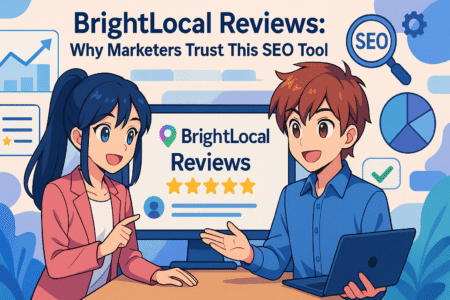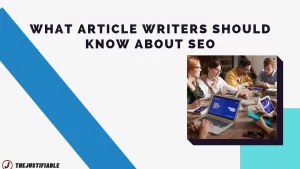Table of Contents
Are you struggling to increase your website’s visibility on search engines? Do you want to know how a well-crafted SEO strategy can propel your site to the top of search results?
In this article, we’ll dive deep into the essential steps you need to create a winning SEO strategy for your website. From identifying the right keywords to implementing technical optimizations, we’ll cover everything you need to succeed.
Whether you’re a beginner or an experienced webmaster, this guide will equip you with actionable insights to boost your site’s performance. Ready to start crafting your SEO strategy?
Understanding the Basics of SEO Strategy

SEO strategy is essential for any website that aims to increase its visibility on search engines. By creating a plan that aligns with search engine algorithms, you can improve your rankings and attract more organic traffic. Let’s dive deeper into how this works.
What is an SEO Strategy and Why is it Important?
An SEO strategy is a roadmap designed to improve your website’s position in search engine results. I believe it’s vital because it allows you to tailor your content and technical aspects to what users are searching for. A strong SEO strategy boosts your visibility and credibility.
A well-structured SEO strategy helps you target the right audience. When search engines see that your content is relevant to users’ queries, they rank it higher. I suggest creating an SEO strategy that focuses on both short-term wins and long-term goals.
For me, an SEO strategy is not just about ranking—it’s about building authority and trust with your audience. This takes time, but the payoff is worth it, as a good strategy will drive sustainable, organic growth to your site.
Key Components of a Solid SEO Strategy
An effective SEO strategy has multiple components, each playing a crucial role. I often recommend focusing on on-page SEO, off-page SEO, and technical SEO. Together, these elements work to improve both your website’s content and its overall structure.
On-page SEO involves optimizing individual pages to rank higher and attract relevant traffic. It includes keyword placement, meta descriptions, and content quality. I’ve noticed that keeping content user-friendly while using the right keywords can make a huge difference.
Off-page SEO refers to the actions taken outside of your website to improve its ranking. I always suggest building a strong backlink profile because it shows search engines that your site is trustworthy and authoritative.
How SEO Strategy Impacts Website Ranking
I think an SEO strategy directly affects how search engines perceive your website. The better your strategy, the more likely it is that search engines will rank your content higher. I find that focusing on user experience, content relevance, and technical performance can lead to better rankings.
Google and other search engines use algorithms that analyze your site’s content, speed, mobile optimization, and backlinks. If all these elements are optimized, I’m confident you’ll see a significant improvement in your rankings.
When you craft a solid SEO strategy, you’ll notice a gradual boost in organic traffic. The key is consistency—keeping your SEO efforts going will pay off over time, ensuring that your website ranks for the keywords that matter most to your audience.
Aligning SEO Strategy with Your Business Goals
A successful SEO strategy should always be aligned with your business goals. I think it’s crucial to know what you want to achieve before diving into optimization. Whether it’s increasing sales, boosting engagement, or driving traffic, your SEO efforts should reflect these objectives.
I always advise focusing on metrics that match your goals. If you’re aiming for more traffic, monitor organic search volume. For e-commerce, conversions should be a primary focus. By aligning your strategy with your goals, you can ensure that SEO supports your broader business objectives.
Your SEO strategy can help drive business growth, but only if it’s tailored to your needs. I suggest setting specific, measurable goals for your SEO plan, so you can track progress and adjust your tactics as necessary.
Conducting Effective Keyword Research for SEO Success

Keyword research is the foundation of any successful SEO strategy. Without targeting the right keywords, your content may never reach its intended audience. Let’s explore how effective keyword research can enhance your SEO efforts.
Why Keyword Research is Critical for SEO Strategy
Keyword research is essential because it allows you to understand what users are searching for. I’ve found that targeting the right keywords brings more relevant traffic to your website. It’s crucial for driving organic growth and ensuring your content appears in search results.
In my experience, keyword research helps identify gaps in your content. By focusing on terms with high search volumes and low competition, you can stand out in your niche. It’s one of the most important aspects of any SEO strategy.
I recommend integrating keyword research into every stage of content creation. Without it, you might miss out on opportunities to rank for important terms that your competitors are targeting. It’s a vital step to ensure your strategy is effective.
Using Keyword Tools to Find Relevant Search Terms
To find the right keywords, I suggest using tools like Google Keyword Planner or SEMrush. These tools help you discover what your audience is searching for, and I think they make the process easier by providing data on search volume, competition, and trends.
I’ve noticed that using multiple tools often yields the best results. You can cross-reference data to ensure the keywords you choose are relevant and achievable. Tools like Moz or Ahrefs also help identify related terms you may not have considered.
Once you’ve gathered a list of potential keywords, I recommend narrowing it down by focusing on those that align with your content goals. These tools give you the insights needed to make informed decisions, ensuring that your keyword strategy is effective.
How to Identify High-Volume, Low-Competition Keywords
High-volume, low-competition keywords are the sweet spot for any SEO strategy. I think these keywords provide the best chance to rank without too much competition. Finding them requires research, but I’ve found the results to be well worth the effort.
Start by looking for keywords that have a high search volume but aren’t overly competitive. I recommend using long-tail keywords, as they tend to have lower competition while still driving targeted traffic. They are easier to rank for, especially for newer sites.
I often focus on niche-specific terms. These keywords may not have the highest search volume, but they attract highly engaged users. Over time, ranking for several low-competition keywords can add up, bringing in significant traffic.
LSI Keywords and Their Importance in SEO Strategy
Latent Semantic Indexing (LSI) keywords are related terms that give search engines more context about your content. I believe using LSI keywords helps you avoid overstuffing primary keywords while still signaling relevance. It makes your content more natural and user-friendly.
I’ve found that incorporating LSI keywords into content enhances its depth and breadth. These related terms help search engines understand the broader topic of your page. It’s an important step that complements your focus keyword without making the content repetitive.
When I create content, I often identify LSI keywords by simply brainstorming related terms. Tools like LSIGraph can also help. Using these keywords strategically can improve your chances of ranking for multiple related queries.
How to Integrate Focus Keywords into Your Content
I suggest placing your focus keyword naturally throughout your content. It’s important to include it in key areas like the title, headings, and the first 100 words. This ensures search engines understand the primary topic of your page without overdoing it.
I’ve learned that sprinkling your focus keyword throughout the text—not just in the introduction or conclusion—creates a natural flow. This also helps search engines scan your content more effectively. Overuse can hurt your rankings, so I always aim for a balanced approach.
To me, the best way to integrate focus keywords is by weaving them into the content organically. Using variations of the keyword and related phrases makes your writing sound more conversational, which I find engages readers while keeping SEO intact.
On-Page Optimization: Boosting SEO Strategy Performance
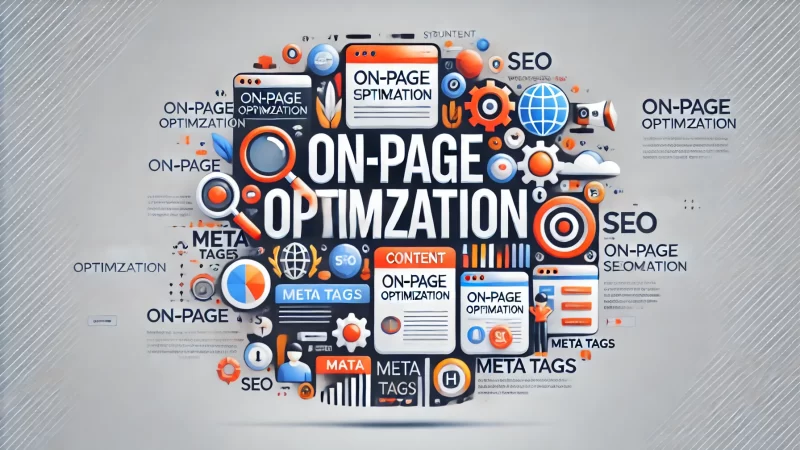
On-page optimization plays a critical role in the success of your SEO strategy. It involves refining various elements of your website to make it more search engine-friendly and user-focused. Let’s explore how optimizing these key areas can boost your SEO performance.
Optimizing Title Tags and Meta Descriptions for SEO
Title tags and meta descriptions are essential for drawing attention in search results. I suggest crafting titles that include your main keyword and catch users’ eyes. A well-optimized title helps improve click-through rates, while meta descriptions offer a concise preview of your content.
Meta descriptions should be informative yet concise, with a call to action that encourages users to click through. I’ve seen how strategic use of keywords within the description can subtly signal relevance to both users and search engines. However, keep it natural to avoid keyword stuffing.
Including your focus keyword in the title tag, but ensuring it reads naturally, is key. I always prefer title tags that not only optimize for SEO but also make sense to a human reader. It strikes the perfect balance between search engine needs and user experience.
Best Practices for Creating SEO-Friendly URLs
An SEO-friendly URL structure helps both search engines and users navigate your site. I suggest keeping URLs short and clean, including focus keywords without unnecessary words. A descriptive URL improves clarity and makes it easier for users to know what to expect from the page.
I’ve noticed that hyphenating words in URLs, rather than using underscores or spaces, is the best approach. This makes URLs easier to read, and search engines prefer this format. I find that clear, straightforward URLs contribute to higher rankings because they improve the user experience.
Avoid using numbers or random characters in URLs. I think descriptive URLs that match the content of the page also help build trust with users, making them more likely to click on the link. In my experience, the simpler and cleaner the URL, the better the SEO performance.
Importance of Header Tags in SEO Strategy
Header tags (H1, H2, H3) not only structure your content but also signal its hierarchy to search engines. I believe using keywords in header tags enhances your SEO, as it helps search engines understand the topic of each section. However, it’s important to use them naturally.
H1 tags should be reserved for the main title of your page, while H2 and H3 tags break down the content into organized sections. I often recommend using H2 tags for main topics and H3 tags for subtopics, ensuring a clear flow of information that’s easy to follow.
Each header tag should be meaningful, offering valuable context for both readers and search engines. I emphasize that headers should help guide users through your content, making it easier to scan and digest while boosting SEO rankings by enhancing page structure.
Enhancing Website Content with SEO Best Practices
High-quality content is essential for a successful SEO strategy. I advise focusing on creating content that is engaging, informative, and valuable to the reader. Incorporating keywords naturally within the content, rather than forcing them, improves both SEO and user experience.
When I write, I aim to include a mix of short and long sentences, as well as bullet points and images, to keep the reader engaged. This variation in structure not only makes content more readable but also enhances its SEO value by encouraging longer user sessions.
I suggest regularly updating your content to keep it relevant and fresh. Search engines love fresh content, and I’ve noticed that regularly adding new information to existing articles can improve rankings. Keeping content aligned with user intent is key to long-term SEO success.
Improving Readability and User Engagement for Better SEO
Readability plays a crucial role in SEO performance. I recommend writing in simple, conversational language to ensure your content is easy to read. If users can engage with your content comfortably, they’ll stay on your site longer, which signals to search engines that your content is valuable.
Short paragraphs, clear headings, and bullet points make it easier for readers to find what they’re looking for. I find that well-structured content encourages user engagement, reducing bounce rates and improving overall site performance. This, in turn, boosts your SEO rankings.
User engagement also includes interactive elements, such as quizzes or comment sections. I suggest adding these where appropriate, as they can encourage readers to spend more time on your site. The more engaged users are, the better your SEO performance will be.
Technical SEO: Enhancing Website Performance
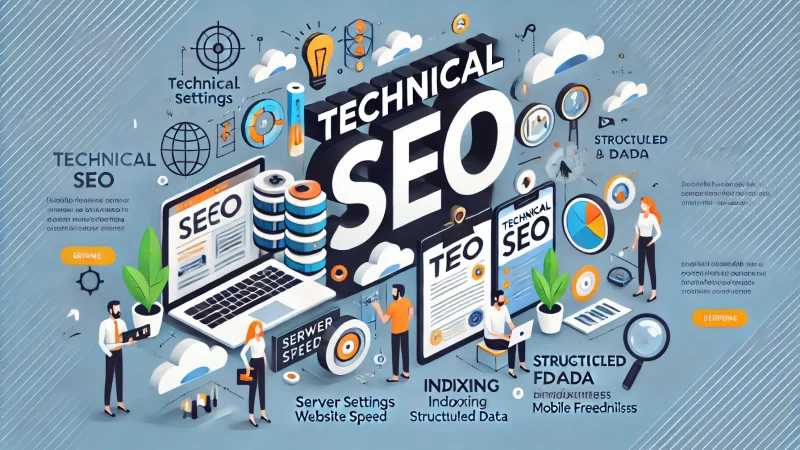
Technical SEO focuses on improving the backend elements of your website to ensure it’s optimized for search engines. By enhancing your site’s performance, you’ll improve its ability to rank higher and provide a better user experience. Let’s break down the key technical elements.
Improving Site Speed to Boost Your SEO Strategy
Site speed is one of the most critical factors affecting both user experience and SEO. I suggest optimizing your website’s loading time by compressing images, enabling browser caching, and minimizing HTTP requests. A faster website improves user satisfaction and boosts rankings.
I’ve seen slow-loading pages lead to higher bounce rates, as users are less likely to wait. Search engines notice this and may penalize your site. By ensuring your pages load quickly, you increase the chances of ranking higher and keeping users engaged on your site.
Tools like Google PageSpeed Insights can help you identify areas that need improvement. I recommend using these tools regularly to monitor your site’s speed and make necessary adjustments to enhance performance.
Why Mobile Optimization is Essential for SEO Strategy
With more users accessing websites through mobile devices, mobile optimization is now a top priority for SEO success. I always advise ensuring your site is mobile-friendly, as search engines prioritize mobile-optimized sites, especially with Google’s mobile-first indexing.
Mobile optimization involves responsive design, meaning your site should automatically adjust to fit any screen size. I think testing your site across different devices is key to providing a seamless user experience. This approach improves engagement and helps boost your SEO.
I also suggest checking mobile page speed, as mobile users expect fast-loading pages. Ensuring your content is easily accessible and readable on smaller screens can lead to higher rankings and better user satisfaction, which ultimately benefits your SEO strategy.
Understanding Structured Data and How it Improves SEO
Structured data, often referred to as schema markup, helps search engines understand the content on your website better. I recommend using schema to highlight key information such as product details, reviews, or FAQs. This enhances the way your site appears in search results.
By implementing structured data, your site may become eligible for rich snippets, which improve visibility and click-through rates. I find that adding structured data helps search engines interpret the relevance of your content, leading to improved rankings.
I’ve noticed that using tools like Google’s Structured Data Testing Tool can help ensure your markup is correctly implemented. Schema not only enhances search engine understanding but also provides users with more detailed and relevant information directly in search results.
Optimizing Your Website’s Crawlability and Indexability
Crawlability refers to how easily search engines can explore your website, while indexability is about how well they can index its content. I recommend ensuring your site’s architecture is simple and easy for search engine bots to navigate, as this improves your SEO performance.
I find that creating a clear site hierarchy and using internal linking can help guide search engines to the most important pages. Making sure no essential pages are blocked by your robots.txt file or meta tags is crucial for proper indexing.
XML sitemaps and clean code also contribute to better crawlability. I suggest regularly updating your sitemap to reflect new content. This way, search engines can quickly identify and index new pages, improving your site’s visibility.
The Importance of an SEO-Friendly Sitemap
An SEO-friendly sitemap acts as a roadmap for search engines, showing them which pages to crawl and index. I always advise creating a dynamic sitemap that updates automatically when new content is added, ensuring that all pages are properly indexed by search engines.
Sitemaps also improve the chances of your content being discovered by search engines faster. I find that submitting a sitemap to tools like Google Search Console helps ensure that your site is crawled efficiently, improving the visibility of new and existing pages.
I recommend keeping your sitemap organized, with clean URLs and no unnecessary parameters. This not only improves the crawlability of your site but also ensures that search engines can easily navigate and index your most important content.
Building a Strong Backlink Profile to Boost SEO Strategy

Building a strong backlink profile is a key component of any successful SEO strategy. High-quality backlinks improve your website’s credibility and trustworthiness, which search engines take into account when ranking content. Let’s explore how to create and maintain a robust backlink profile.
The Role of Backlinks in Your SEO Strategy
Backlinks are like votes of confidence from other websites. When reputable sites link to your content, search engines perceive your website as valuable and trustworthy. I’ve found that earning quality backlinks significantly improves your chances of ranking higher in search results.
Quality backlinks signal to search engines that your site offers authoritative information. The more high-quality links you acquire, the more visibility you’ll gain. I recommend focusing on backlinks from relevant and trusted sources to maximize the impact on your SEO strategy.
Backlinks don’t just boost rankings—they also drive referral traffic. I’ve seen how visitors who come from trusted sites tend to engage more with content. This not only enhances user experience but also strengthens your SEO performance by reducing bounce rates.
However, not all backlinks are created equal. I suggest avoiding low-quality, spammy links, as they can hurt your SEO. Instead, focus on building relationships with reputable websites to create a backlink profile that elevates your site’s authority and trustworthiness.
How to Identify High-Quality Backlink Opportunities
Identifying high-quality backlink opportunities is crucial to building a strong backlink profile. I recommend looking for websites with high domain authority in your niche. These sites carry more weight in search engines’ eyes, making their backlinks more valuable.
Guest posting is an excellent way to earn quality backlinks. I’ve noticed that writing high-quality articles for authoritative sites allows you to showcase your expertise while earning a valuable link back to your site. It’s a win-win for both parties involved.
Building relationships with industry influencers can also open up backlink opportunities. I’ve found that networking with influential bloggers or content creators can result in natural backlinks when they reference your content in their posts. This often happens organically.
You should also use tools like SpyFu or SEMrush to analyze your competitors’ backlink profiles. I suggest identifying which sites are linking to them and finding ways to earn similar backlinks. This approach gives you an edge by targeting proven, quality sources.
Best Practices for Earning and Building Backlinks
To build a strong backlink profile, I recommend creating valuable content that others will want to link to. I’ve seen that high-quality, informative articles naturally attract backlinks because they provide value to other websites and their audiences.
Earning backlinks through outreach is another effective strategy. I think reaching out to websites that might find your content useful can result in natural backlinks. It’s important to personalize your outreach and explain how linking to your content benefits their audience.
Content formats like infographics, videos, and comprehensive guides are particularly shareable. I’ve noticed that these types of content are often cited by other websites, making them great assets for earning backlinks. The more engaging your content, the more likely it is to attract links.
I also recommend staying active on social media to promote your content. When your content gets shared widely, it’s more likely to catch the attention of bloggers and industry experts who may link back to it. This is a simple way to increase your backlink potential.
Monitoring and Maintaining a Healthy Backlink Profile
It’s important to monitor your backlink profile regularly. I suggest using tools like Serpstat to keep track of your backlinks. This helps you identify any problematic or low-quality links that might harm your SEO efforts.
I think maintaining a healthy backlink profile is about quality over quantity. I’ve seen how regularly auditing your backlinks can help you remove harmful links that might be dragging your site down. It’s better to have fewer high-quality backlinks than many low-quality ones.
When I monitor backlinks, I look for any sudden spikes in link acquisition, which can sometimes indicate spammy or unnatural links. If you notice anything suspicious, it’s crucial to address it right away to protect your site’s SEO performance.
Keeping a healthy backlink profile isn’t just about removing bad links; it’s also about consistently earning new ones. I advise continuing to create valuable content and nurturing relationships with reputable sites to ensure your backlink profile stays strong and grows over time.
Disavowing Harmful Links That Hurt Your SEO
Harmful backlinks can damage your SEO if left unchecked. If you identify low-quality or spammy backlinks, I recommend disavowing them using Google’s Disavow Tool. This tells Google not to take those links into account when evaluating your website.
Spammy backlinks can come from link farms or sites with low domain authority. I’ve seen how these links can negatively impact rankings, so it’s essential to monitor and remove them. Disavowing bad links can help restore your site’s reputation in the eyes of search engines.
When disavowing links, I advise being selective. You don’t want to disavow links from sites that are low-quality but still legitimate. I recommend focusing on clearly harmful links that have no relevance to your content or industry.
The disavow process is a safety net but shouldn’t be your main strategy. I believe the best approach is to avoid acquiring bad backlinks in the first place by focusing on high-quality link-building methods. Prevention is always better than cure when it comes to SEO.
Content Creation and SEO: The Perfect Partnership

Content creation and SEO go hand in hand. Without valuable content, your SEO efforts will fall flat. Well-crafted content helps search engines understand what your site is about, while also engaging and informing your audience. Let’s explore how content fuels your SEO strategy.
How Content Affects Your Overall SEO Strategy
Content is the backbone of any SEO strategy. Search engines rely on content to determine the relevance of your site to user queries. I believe that by consistently creating high-quality content, you can improve your website’s visibility and ranking.
Content allows you to target specific keywords that your audience is searching for. I recommend using your primary keyword naturally throughout your content to help search engines understand its relevance. This will improve your chances of ranking for important search terms.
I’ve found that content also plays a huge role in user engagement. When your content is valuable, users spend more time on your site, which signals to search engines that your site is worth ranking higher. The more engaging your content, the better your SEO performance.
It’s important to create content that aligns with user intent. I suggest focusing on answering the questions and solving the problems your audience is searching for. This not only improves your SEO but also builds trust and credibility with your audience.
Creating Valuable and Optimized Content for SEO Success
Creating valuable content is key to SEO success. I recommend focusing on topics that resonate with your target audience. The more useful and relevant your content is, the more likely it is to rank well and attract backlinks from other sites.
Keyword optimization is essential, but I suggest using keywords naturally within the text. I’ve seen that over-optimization can hurt your rankings, so it’s important to prioritize readability and user experience. Use keywords strategically but avoid keyword stuffing.
I’ve learned that visual elements, such as images and videos, can enhance your content and improve SEO. Search engines favor content that includes multimedia, as it keeps users engaged. I think this is a great way to increase time spent on your site and lower bounce rates.
I advise keeping your content well-structured with clear headings and subheadings. This not only improves readability but also helps search engines understand the hierarchy of your content. The easier it is for users and search engines to navigate, the better your SEO performance.
How to Keep Content Fresh and Relevant for SEO
Fresh content is important for maintaining SEO rankings. I suggest regularly updating old content with new information to keep it relevant. Search engines prioritize fresh content, so this is a simple way to stay competitive without creating entirely new content.
Updating content also shows users that your site is current and reliable. I’ve noticed that adding new statistics, examples, or insights to old articles can breathe new life into them. It’s a quick way to improve SEO without starting from scratch.
Repurposing content into different formats, like turning blog posts into videos or infographics, is another way to keep things fresh. I recommend exploring various content types to keep your audience engaged while improving your site’s SEO value.
Keeping content relevant also involves staying on top of trending topics in your industry. I suggest monitoring current trends and updating your content to reflect the latest information. This ensures that your content remains useful and continues to rank well over time.
The Power of Long-Form Content in SEO Strategy
Long-form content has a powerful impact on SEO. I recommend creating in-depth articles that cover topics comprehensively. Search engines favor longer content because it tends to provide more value to users. In my experience, long-form articles are more likely to rank for multiple keywords.
Long-form content allows you to explore a topic in greater detail. I’ve found that this format gives you more opportunities to naturally incorporate keywords and related terms. It’s a great way to cover all aspects of a subject and signal to search engines that your content is thorough.
I also suggest including internal and external links in long-form content. Linking to other relevant pages on your site improves SEO by boosting page authority. External links to trusted sources also help build credibility with search engines and your audience.
Although long-form content requires more effort, I think it’s worth it for the long-term SEO benefits. Readers and search engines alike appreciate detailed content that thoroughly answers questions and solves problems, making it a valuable part of your SEO strategy.
Optimizing Blog Posts for Higher Rankings in Search Engines
Optimizing blog posts is crucial for improving their search engine rankings. I suggest starting with a keyword-rich title that grabs attention. Titles are often the first thing users see, and a well-crafted one can encourage clicks and improve rankings.
I’ve found that including the primary keyword in the first 100 words of a blog post helps search engines understand its relevance. However, I suggest avoiding keyword stuffing. Instead, focus on writing naturally and letting the keywords flow within the content.
Using internal links to other blog posts is a great way to optimize content. I recommend linking to related articles within your site to keep users engaged and guide them through more of your content. This helps reduce bounce rates and boosts SEO.
I also suggest optimizing meta descriptions with relevant keywords. While they don’t directly affect rankings, well-crafted meta descriptions improve click-through rates, which can positively impact SEO. It’s an easy yet effective way to optimize your blog posts for better performance.
Local SEO Strategy: Targeting Nearby Customers
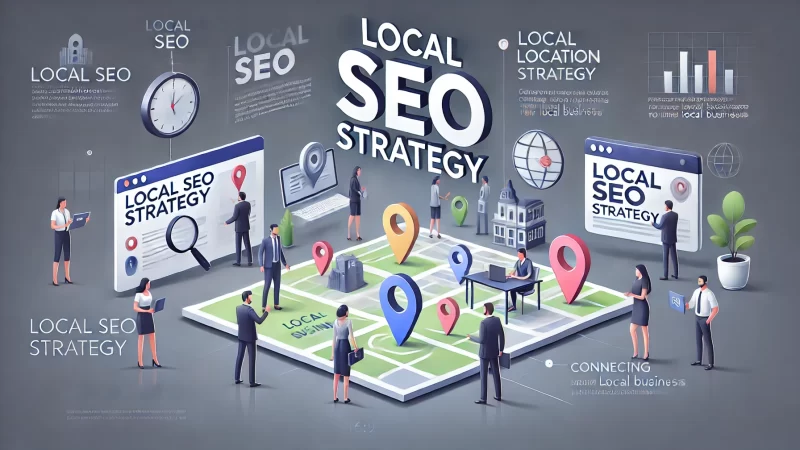
A solid local SEO strategy helps businesses reach nearby customers more effectively. By optimizing your website and online presence for local searches, you’ll attract people in your area who are actively looking for services or products that you offer.
Why Local SEO is Crucial for Small Businesses
Local SEO is especially important for small businesses because it focuses on reaching customers nearby. I’ve seen firsthand how businesses benefit from appearing in local searches, as potential customers often choose nearby options when searching for products or services.
Ranking in local search results helps businesses compete against larger companies by targeting a more specific audience. I believe that when small businesses optimize for local searches, they not only increase visibility but also gain more foot traffic and phone inquiries.
Google prioritizes local businesses in search results, especially when users search with “near me” or specific location terms. I think small businesses should take advantage of this by building a strong local SEO presence to connect with customers in their area.
Local SEO also fosters trust within the community. I’ve noticed that when small businesses rank well locally, it boosts their credibility among potential customers. Being a recognized name in your area makes people more likely to choose your business over competitors.
Optimizing Your Google My Business Profile for SEO
Google My Business (GMB) is one of the most powerful tools for local SEO. I recommend keeping your GMB profile updated with accurate business information, including your address, phone number, and operating hours. This improves your chances of appearing in local searches.
Uploading high-quality images to your GMB profile is essential. I find that businesses with engaging photos tend to attract more attention. Images of your storefront, products, or services help customers feel connected to your business before they even visit.
I suggest asking satisfied customers to leave reviews on your GMB profile. Positive reviews improve your local SEO rankings and build trust with potential customers. I’ve noticed that businesses with higher ratings tend to perform better in local search results.
Ensure that you’re regularly updating your GMB profile with new posts, promotions, or events. This keeps your business active and visible in search results. I think keeping your profile fresh and engaging is a simple yet effective way to boost local SEO.
How to Use Local Keywords in Your SEO Strategy
Local keywords are essential for targeting nearby customers. I recommend incorporating location-based terms into your website content, such as city names or neighborhood landmarks. This helps search engines understand that your business serves a specific geographic area.
I’ve found that long-tail keywords with location-specific phrases work well for local SEO. For example, instead of just targeting “bakery,” you could focus on “best bakery in downtown Chicago.” These longer, more specific phrases attract users who are closer to making a purchase.
Using local keywords in meta descriptions, headings, and image alt text is a great way to optimize your entire site for local SEO. I suggest weaving these keywords naturally into your content to ensure readability while enhancing SEO performance.
I think creating location-specific landing pages can also boost local SEO. For businesses with multiple locations, each page can be optimized with unique keywords and information. This not only improves search rankings but also helps customers find the nearest location more easily.
Building Citations and Reviews to Boost Local SEO
Citations—mentions of your business’s name, address, and phone number (NAP) on other websites—are vital for local SEO. I recommend submitting your NAP information to local directories like Yelp, TripAdvisor, and industry-specific directories. This improves your business’s credibility.
Consistent NAP information across the web is crucial. I advise checking that your business’s details are accurate on every site. Search engines favor businesses with consistent citations, so keeping your information up to date is key to improving local SEO rankings.
Encouraging customers to leave reviews is one of the most effective ways to boost your local SEO. I’ve seen how positive reviews not only build trust but also improve your rankings in search results. I suggest making it easy for customers to review your business by providing direct links.
I also recommend responding to reviews, whether they’re positive or negative. Engaging with customers shows that you care about their feedback, and search engines notice this interaction. It’s a great way to improve customer relationships and enhance local SEO.
Creating Location-Specific Content to Enhance SEO Strategy
Location-specific content helps businesses rank for local search queries. I suggest creating blog posts or landing pages that focus on events, news, or activities in your area. This content attracts local customers while boosting your local SEO performance.
Including local keywords in your content is important, but I believe the content must also be valuable and relevant to your audience. Whether it’s a guide to the best spots in your city or advice on local trends, content should offer useful insights while improving SEO.
I’ve noticed that collaborating with local influencers or businesses can also enhance your SEO. Co-creating content that highlights local collaborations not only improves your visibility but also helps you reach a broader audience through shared promotion efforts.
Don’t forget to optimize your content for mobile users. Since many local searches are conducted on mobile devices, I recommend ensuring that your site is mobile-friendly. This improves the user experience and helps your business rank higher in mobile search results.
Monitoring and Measuring SEO Strategy Performance
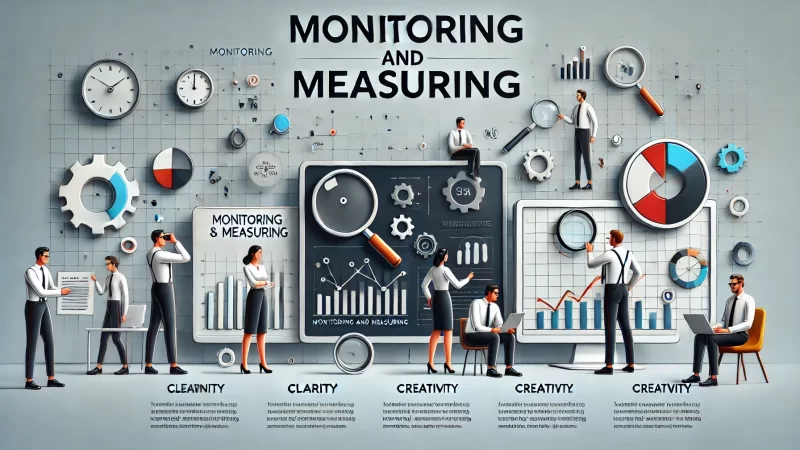
Monitoring your SEO strategy’s performance is crucial for making adjustments and improvements. Tracking key metrics helps you understand what’s working and what needs refinement. Let’s dive into the tools and techniques for effectively measuring your SEO progress.
Essential SEO Metrics to Track for Strategy Success
I suggest focusing on several key metrics to evaluate your SEO performance. Organic traffic, keyword rankings, and click-through rates (CTR) are vital indicators of how well your strategy is working. Keeping an eye on these can help guide future optimizations.
Bounce rate and time on site are also important metrics to track. I’ve found that a high bounce rate might indicate that users aren’t finding what they’re looking for. Optimizing your content to keep users engaged can help lower this rate and improve your SEO.
Conversion rates are a direct reflection of your SEO success. If users are completing desired actions, like filling out a form or making a purchase, your SEO strategy is working. I recommend analyzing conversion rates to ensure your SEO efforts are translating into real results.
I’ve learned that tracking backlink growth is also essential. A strong backlink profile can dramatically improve your SEO, so monitoring the quantity and quality of your backlinks provides valuable insights into your strategy’s effectiveness.
Using Google Analytics to Evaluate SEO Performance
Google Analytics is an indispensable tool for tracking SEO performance. I recommend using it to monitor organic traffic trends, including which pages are attracting the most visitors. This data can help you refine your SEO strategy by identifying high-performing content.
I find that Google Analytics also provides insights into user behavior, like how long visitors stay on your site and which pages they view the most. This information helps you understand which aspects of your site are working well and where improvements are needed.
Tracking referral traffic in Google Analytics is important as well. If you notice that traffic is coming from certain websites, it’s a good indication that your backlink strategy is working. I suggest analyzing this data to determine which backlinks are driving the most traffic.
The goal completions feature in Google Analytics allows you to track conversions. I recommend setting up goals based on actions like form submissions or purchases. This helps you measure the effectiveness of your SEO in driving conversions.
How to Use Search Console for SEO Strategy Insights
Google Search Console offers valuable data on how your site appears in search results. I suggest using it to track keyword rankings, monitor site performance, and identify any issues that could be affecting your SEO. This tool provides critical insights for refining your strategy.
Search Console’s “Performance” tab shows which queries are driving traffic to your site. I’ve found this data useful for identifying new keyword opportunities and optimizing existing content. It’s a great way to ensure your strategy is aligned with what users are searching for.
The “Coverage” section in Search Console highlights any errors or issues with indexing. I recommend regularly checking this area to ensure all your pages are being properly crawled and indexed by search engines. Fixing these issues promptly is key to maintaining good SEO health.
I also think the “Links” tab in Search Console is important for monitoring backlinks. This section shows which sites are linking to you and helps you identify potential opportunities for improving your backlink profile. Strong backlinks are essential for SEO success.
Adjusting Your SEO Strategy Based on Performance Data
SEO is not a one-time effort. I believe regularly analyzing performance data and making adjustments is crucial for staying ahead. If certain keywords aren’t performing well, I suggest refining your content or targeting new keywords to maintain steady growth.
When bounce rates or exit rates are high, I recommend reevaluating the content on those pages. It’s possible that the information isn’t relevant or engaging enough for users. Improving these areas can lead to better rankings and a lower bounce rate over time.
If your website’s mobile performance is lacking, I suggest optimizing your site for mobile responsiveness and speed. This is particularly important because mobile-first indexing means search engines prioritize mobile versions of your site in search rankings.
Conversion rate data is also key to making strategic adjustments. If conversions are low despite high traffic, I think it’s important to examine your calls to action and landing page design. Simple tweaks here can improve both user experience and conversion rates.
Tools to Continuously Monitor Your SEO Progress
To continuously monitor SEO progress, I suggest using tools like Ahrefs, SEMrush, or Moz. These platforms provide in-depth analysis of your keyword rankings, backlinks, and competitor strategies. I’ve found that using these tools gives a comprehensive view of your SEO health.
These tools can also alert you to changes in rankings or keyword performance. I recommend setting up alerts to notify you when important metrics fluctuate. This helps you stay on top of your SEO strategy and make timely adjustments when needed.
Another valuable tool is Screaming Frog, which I suggest using for auditing your website. It crawls your site and provides insights into technical SEO issues, broken links, and missing metadata. Regular audits help keep your site in good shape for search engines.
Finally, Google Alerts can help you monitor mentions of your brand across the web. I’ve seen how this tool keeps businesses informed about new backlinks or mentions, which can be useful for maintaining a strong online presence and improving SEO performance.
SEO for E-Commerce: Special Considerations

Optimizing an e-commerce website for SEO requires special considerations to ensure your products are visible in search results. By focusing on both product pages and the overall user experience, e-commerce sites can see substantial improvements in rankings and sales.
Optimizing Product Pages to Boost SEO Performance
Product pages are the backbone of e-commerce SEO. I recommend ensuring each product page has a unique, keyword-rich title and meta description. These elements help search engines understand what the page is about, improving the chances of ranking well.
High-quality product descriptions that include natural keyword placement are essential. I suggest creating detailed descriptions that highlight the benefits and features of your products. This approach improves both user experience and SEO performance.
I’ve noticed that using optimized product images with descriptive alt text enhances the SEO value of your product pages. Search engines can’t “see” images, but they can read the alt text, so it’s important to use relevant keywords here.
Internal linking between product pages and other relevant sections of your site can boost SEO. I advise linking to related products or categories to help search engines crawl your site more efficiently while providing users with a smoother shopping experience.
Using SEO Strategy to Increase E-Commerce Sales
A well-crafted SEO strategy can drive more traffic and boost sales. I suggest targeting long-tail keywords that reflect purchase intent, such as “buy affordable running shoes online.” These keywords help attract users who are ready to make a purchase.
Category pages play a crucial role in e-commerce SEO. I recommend optimizing them with relevant keywords and clear, concise content that explains what products are offered. This helps users find what they need while improving your site’s SEO.
Creating compelling meta descriptions for product and category pages is a great way to improve click-through rates. I find that including a call to action, like “shop now,” can entice users to visit your site, ultimately leading to more sales.
User-generated content, such as reviews, can also improve SEO and sales. I’ve seen that when customers leave reviews, it adds fresh, relevant content to your product pages, which search engines favor. This can lead to higher rankings and more conversions.
How User Experience Affects SEO for Online Stores
User experience (UX) is a key factor in SEO, especially for e-commerce sites. I think it’s important to ensure your site is easy to navigate, with clear categories and product filters that help users quickly find what they’re looking for. Good UX keeps users on your site longer, improving SEO.
I recommend optimizing page load speed, as slow pages lead to higher bounce rates. E-commerce sites with fast loading times offer a better user experience, which search engines take into account when ranking sites. Tools like Google PageSpeed Insights can help you identify speed issues.
Mobile optimization is critical for e-commerce success. I’ve noticed that more users are shopping via mobile devices, so I suggest ensuring your site is responsive. This means it should adjust smoothly to different screen sizes, improving both user experience and SEO.
Product pages should also be easy to navigate. I advise using clear calls to action and keeping the checkout process as simple as possible. Reducing friction during the shopping experience not only increases conversions but also signals to search engines that your site is user-friendly.
The Role of Reviews and User-Generated Content in SEO
Reviews and user-generated content (UGC) add credibility to your site and help improve SEO. I recommend encouraging customers to leave reviews, as they provide fresh, authentic content that search engines favor. Reviews also help build trust with potential buyers.
I’ve seen that including customer photos or videos in product reviews can make your content even more engaging. This type of UGC not only improves SEO but also helps new customers see real-life applications of your products, increasing their confidence in making a purchase.
Positive reviews can improve click-through rates from search results. I suggest displaying star ratings and snippets from reviews in Google’s search results using structured data. This enhances your site’s visibility and draws in more traffic.
Negative reviews, when addressed professionally, can also contribute to SEO. I advise responding to all reviews, as it shows that you value customer feedback. Search engines notice this interaction, and it helps build trust with future customers.
Implementing Technical SEO for E-Commerce Websites
Technical SEO is essential for ensuring your e-commerce site is properly crawled and indexed by search engines. I recommend setting up an XML sitemap that includes all your product and category pages. This helps search engines discover your content quickly.
I think it’s important to implement structured data (schema markup) to enhance the visibility of your products in search results. Structured data helps search engines display rich results, such as price, availability, and reviews, directly in the search listings.
Ensuring that your site is mobile-friendly is a technical SEO must. I suggest using responsive design to ensure your site functions well on all devices. Mobile-first indexing means that search engines prioritize mobile-friendly sites, so optimizing for mobile can significantly boost rankings.
Fixing broken links and redirect issues is also key for technical SEO. I recommend regularly auditing your site for 404 errors and implementing proper redirects when necessary. Keeping your site’s technical health in check ensures a smoother user experience and better SEO performance.
Common SEO Mistakes and How to Avoid Them

Avoiding common SEO mistakes can prevent your e-commerce site from losing valuable traffic. Many websites fall into traps like keyword stuffing or ignoring technical SEO, which can negatively impact rankings. Let’s discuss how to avoid these pitfalls.
Keyword Stuffing and Over-Optimization Pitfalls
Keyword stuffing occurs when too many keywords are forced into content unnaturally. I recommend using keywords naturally throughout your content to avoid penalties from search engines. Over-optimization can make your content unreadable, driving users away.
I’ve noticed that focusing too heavily on one keyword can also limit your SEO potential. I suggest incorporating related keywords and long-tail variations to cover a broader range of search queries. This ensures that your content remains relevant without feeling repetitive.
When optimizing for SEO, balance is key. I think it’s important to prioritize the user experience while still incorporating SEO best practices. Focusing solely on keyword density can make your content feel mechanical, which is why a natural flow is always better.
Over-optimized anchor text is another common mistake. I advise avoiding the use of exact-match keywords in every link. Instead, I suggest varying your anchor text to make it more diverse and natural, improving both readability and SEO.
Ignoring Technical SEO and Its Impact on Strategy
Ignoring technical SEO can lead to serious ranking issues. I’ve seen how slow site speed, broken links, or unoptimized mobile performance can harm a website’s visibility. Technical problems make it difficult for search engines to crawl and index your site efficiently.
Mobile optimization is often overlooked. I recommend ensuring your site is responsive and loads quickly on mobile devices. Since more users are shopping via smartphones, neglecting mobile SEO can result in lost traffic and sales opportunities.
Duplicate content is another technical SEO issue that can affect rankings. I suggest using canonical tags to indicate the preferred version of a page. This helps prevent search engines from penalizing your site for having identical or very similar content on multiple pages.
I also think that optimizing your site’s URL structure can help. Clean, descriptive URLs improve both user experience and SEO. Avoid long, complicated URLs with unnecessary characters. Simple, keyword-rich URLs are easier for search engines to understand and rank.
Duplicate Content Issues and How They Hurt SEO
Duplicate content confuses search engines about which version of a page to index, potentially lowering your rankings. I recommend creating unique content for each page to avoid this issue. Rewriting product descriptions or blog posts is a simple way to maintain originality.
I’ve noticed that e-commerce sites often struggle with duplicate content due to similar product listings. To combat this, I suggest varying product descriptions or using canonical tags to indicate the primary page. This ensures your pages won’t compete against each other in search results.
User-generated content can also lead to duplicate content if not managed properly. I advise moderating comments and reviews to avoid excessive repetition. This keeps your content fresh while still benefiting from the SEO boost provided by reviews.
It’s also important to ensure your site doesn’t generate multiple versions of the same page due to URL parameters or session IDs. I recommend working with a developer to implement canonicalization or adjust your CMS settings to prevent duplicate content issues.
Misusing Anchor Text in Link Building Strategies
Misusing anchor text can harm your SEO efforts. I suggest avoiding overly optimized anchor text that focuses on exact-match keywords. Instead, I recommend using descriptive, natural-sounding phrases that align with the context of the linked content.
I’ve seen that using generic anchor text like “click here” can weaken your SEO. I advise creating meaningful anchor text that gives users and search engines an idea of what the linked page is about. This improves both user experience and rankings.
Overusing the same anchor text across multiple pages can lead to over-optimization penalties. I suggest diversifying your anchor text to create a more natural link profile. This variety helps search engines view your site as trustworthy and authoritative.
Internal linking is an important part of SEO, but I recommend doing it strategically. Avoid linking excessively within a single piece of content. I’ve found that carefully placed internal links improve user navigation while helping search engines understand the structure of your site.
Not Tracking SEO Metrics: Why It’s a Big Mistake
Not tracking SEO metrics leaves you in the dark about what’s working and what’s not. I suggest using tools like Google Analytics to monitor your traffic, conversion rates, and bounce rates. Regularly reviewing these metrics helps you make informed decisions about your SEO strategy.
I think tracking keyword rankings is essential for evaluating the success of your SEO efforts. I recommend using tools like Ahrefs or SEMrush to see how your target keywords are performing. This data can guide you in refining your content and improving rankings.
If you’re not tracking backlinks, you’re missing out on an important part of SEO. I advise keeping an eye on which sites are linking to yours and assessing the quality of those links. Strong backlinks improve your site’s authority, while low-quality links can hurt your rankings.
Conversion tracking is also key. I’ve found that even if you’re getting plenty of traffic, if conversions aren’t happening, something is off. I suggest analyzing user behavior to identify areas where improvements can be made, leading to better SEO and more sales.
Future-Proofing Your SEO Strategy for Long-Term Success

SEO is constantly evolving, and keeping your strategy adaptable ensures long-term success. To future-proof your SEO, focus on staying informed about algorithm changes, optimizing for new technologies, and embracing emerging trends that keep your site competitive.
Adapting SEO Strategy to Evolving Search Engine Algorithms
Search engine algorithms are always changing, so I recommend keeping up with updates from major players like Google. Changes can impact your rankings, but an adaptable SEO strategy helps mitigate risks. Staying informed allows you to tweak your content and site as needed.
I’ve seen that algorithm updates often focus on improving user experience, so prioritizing high-quality, relevant content can help you stay ahead. I suggest making user experience a core part of your strategy, which will pay off even as algorithms evolve.
Technical SEO also plays a significant role in adapting to algorithm changes. I suggest regularly auditing your site’s technical health, ensuring fast load times, mobile optimization, and easy navigation. These factors are key to keeping your site search engine-friendly.
Diversifying your traffic sources is another great way to safeguard your SEO. Relying too heavily on search traffic makes you vulnerable to algorithm changes. I believe incorporating social media, email marketing, and other channels can create a more resilient strategy.
Why Voice Search Should Be Part of Your SEO Strategy
Voice search is growing, and I recommend incorporating it into your SEO strategy. People search differently when speaking, often using more conversational, long-tail keywords. Optimizing for voice queries can help you reach a broader audience and future-proof your SEO.
I’ve noticed that voice search often focuses on local searches. Including location-based keywords can help you capture these queries. I suggest ensuring your content answers common questions users might ask via voice assistants, which can boost your rankings.
Since voice searches tend to be question-based, I think creating content that directly addresses these questions is a smart move. Structured snippets and FAQs work well for this, improving your chances of being featured in voice search results.
Also, optimizing for mobile is crucial, as most voice searches happen on smartphones. I advise ensuring your site is mobile-friendly and loads quickly, as this enhances the user experience for voice search users and boosts your chances of ranking well.
Optimizing for AI and Machine Learning in SEO
Artificial intelligence (AI) and machine learning are increasingly shaping how search engines rank content. I recommend optimizing your content for AI by focusing on user intent, relevance, and quality. AI algorithms prioritize sites that provide the best answers to user queries.
I’ve learned that AI-driven search engines look for more than just keywords. They analyze how users interact with your site. I suggest improving user engagement metrics like time on page and bounce rates by creating interactive and compelling content.
Content optimization tools that use AI, such as Clearscope or Surfer SEO, can help you understand how to improve your content based on real-time data. I recommend using these tools to refine your SEO efforts and align your content with AI-driven search engines’ expectations.
Personalized search results are another area where AI plays a role. I suggest creating content that caters to different audience segments, offering personalized experiences based on user behavior. This approach can improve your relevance in AI-driven search results.
Staying Ahead of Competitors with an Agile SEO Approach
An agile SEO approach helps you adapt quickly to changes in the market and stay ahead of competitors. I advise regularly analyzing your competitors’ strategies to identify opportunities for growth. Tools like Ahrefs and SEMrush can give you insights into their keywords and backlinks.
I think the key to agility in SEO is testing and iterating. Experimenting with different strategies, like content formats or backlink-building techniques, helps you find what works best. I’ve seen that those willing to adjust their approach quickly tend to perform better in search rankings.
Tracking real-time SEO metrics allows you to make informed decisions. I suggest regularly reviewing your analytics to identify trends and opportunities. This keeps you agile, ensuring that you can capitalize on what’s working and pivot from what isn’t.
Collaborating across teams, such as content, design, and marketing, is essential for an agile SEO strategy. I find that when all teams work together, they can quickly implement changes that improve SEO performance and keep you ahead of the competition.
Embracing Emerging Trends for Continued SEO Success
SEO trends are always changing, and embracing new technologies and techniques keeps your strategy fresh. I believe trends like video content, AI integration, and voice search are here to stay, so incorporating them into your SEO efforts can lead to continued success.
Video content is particularly effective in SEO. I’ve noticed that search engines favor pages with multimedia, as they enhance user experience. I suggest creating engaging videos that complement your written content, making your site more dynamic and appealing to visitors.
The rise of AI-powered search tools means it’s important to focus on user intent rather than just keywords. I recommend analyzing your audience’s needs and providing solutions through your content. This approach aligns with the future direction of search algorithms.
With the increasing importance of mobile searches, I advise optimizing your site for mobile users. Accelerated Mobile Pages (AMP) can improve page load times, and making sure your content is responsive ensures it performs well across devices, securing your SEO success.
Conclusion: Taking Action on Your SEO Strategy
Crafting an effective SEO strategy requires planning, adaptability, and a focus on quality content. Now that you’ve learned how to future-proof your SEO, it’s time to take action. Consistent effort and staying informed about new developments will ensure your long-term success.
Key Takeaways for Crafting a Winning SEO Strategy
To create a winning SEO strategy, I believe you need to focus on quality content, user experience, and staying adaptable to algorithm updates. SEO is not just about keywords; it’s about providing value to users and consistently improving your site’s performance.
Building a strong backlink profile is essential for success. I suggest focusing on earning high-quality backlinks from reputable sites. Strong links signal to search engines that your content is trustworthy and authoritative, improving your rankings over time.
Keyword research remains important, but I advise focusing on long-tail keywords and understanding user intent. This ensures that your content meets the needs of your audience while optimizing for search engines.
Lastly, I’ve seen that measuring performance is key. Continuously monitoring your SEO metrics helps you make data-driven decisions that keep your strategy on track. Regularly refining your approach based on what’s working will lead to long-term SEO success.
Final Tips for Optimizing Your Website for Long-Term Growth
For long-term growth, I recommend focusing on both content creation and technical SEO. Regularly updating your content keeps it fresh, while technical optimizations like page speed, mobile-friendliness, and crawlability ensure search engines can access and rank your pages effectively.
I think investing in local SEO is another important step, especially for businesses that serve specific geographic areas. Optimizing for local keywords and managing your Google My Business profile can drive targeted traffic and help build your reputation in your community.
Keeping an eye on your competitors is crucial. I suggest regularly reviewing their content, backlinks, and keywords to identify gaps in your strategy. Finding ways to differentiate your content helps you stand out and capture more search traffic.
Finally, I advise staying informed about emerging SEO trends. SEO is constantly changing, so attending webinars, reading industry blogs, and networking with SEO professionals can help you stay ahead of the curve and keep your strategy up-to-date.
How to Continuously Improve and Adapt Your SEO Strategy
Continuous improvement is key to staying competitive in SEO. I suggest conducting regular audits to identify any technical issues or areas for content optimization. These audits help you spot opportunities for improvement and ensure your site stays in peak condition.
Tracking keyword rankings, organic traffic, and user behavior gives you valuable insights into what’s working and what needs adjustment. I believe regularly analyzing this data allows you to fine-tune your strategy and stay responsive to market changes.
Experimentation is also important. I’ve seen that testing new content formats, keywords, or backlink strategies can lead to breakthroughs in SEO performance. Don’t be afraid to try something new and iterate based on your findings.
Lastly, I recommend collaborating with other teams in your organization. SEO impacts everything from content creation to marketing, so working together ensures that all aspects of your site are optimized. This holistic approach leads to stronger, more sustainable results.
Frequently Asked Questions About SEO Strategies
How often should I update my SEO strategy to stay competitive?
It’s important to regularly evaluate your SEO strategy, ideally every 3 to 6 months. Search engine algorithms are always evolving, so staying on top of changes and optimizing your content will help you stay competitive and improve rankings.
What are the most important factors in Google’s algorithm for SEO success?
Some of the key factors include high-quality content, backlinks from trusted sources, page speed, mobile optimization, and a strong user experience. Google prioritizes sites that meet these criteria and deliver value to users.
How do I optimize my website for voice search?
To optimize for voice search, focus on long-tail keywords and conversational queries that mimic how people speak. Include FAQ sections in your content, target local keywords, and make sure your site is mobile-friendly and fast-loading.
Can SEO help my small business attract local customers?
Yes, local SEO is crucial for small businesses. Optimizing for local search terms, managing your Google My Business profile, and collecting reviews can help attract nearby customers actively searching for your products or services.
What is the best way to build quality backlinks for my site?
Building quality backlinks involves creating valuable content that others want to link to, guest posting on reputable sites, and forming relationships with influencers in your niche. Tools like Ahrefs and SEMrush can help identify backlink opportunities.
How does user experience (UX) affect my SEO performance?
User experience has a direct impact on SEO. Search engines favor sites that are easy to navigate, mobile-friendly, and fast. Ensuring a seamless user experience encourages visitors to stay longer, which signals to Google that your site offers value.
Is optimizing for mobile really that important for SEO?
Absolutely. With Google’s mobile-first indexing, sites that are not mobile-friendly can lose rankings. Ensure your site is responsive, loads quickly, and offers a great experience on all device sizes to improve both SEO and user satisfaction.
What are long-tail keywords, and why are they important for SEO?
Long-tail keywords are longer, more specific search phrases that usually have lower competition. They’re important because they help you target users with specific search intent, making it easier to rank for niche queries and attract more qualified traffic.
How can I protect my website from being penalized by Google?
To avoid penalties, follow Google’s guidelines by focusing on creating high-quality, original content, avoiding keyword stuffing, and steering clear of black-hat SEO tactics like buying links. Regularly audit your site for issues like duplicate content or broken links.
How can I track my website’s SEO performance over time?
You can track SEO performance using tools like Google Analytics, Google Search Console, and third-party platforms like SEMrush or Ahrefs. Monitor metrics such as organic traffic, keyword rankings, bounce rates, and conversion rates to measure success.
How does content length affect my site’s SEO rankings?
Longer, well-researched content tends to perform better in search results because it’s seen as more comprehensive and authoritative. However, quality is more important than length. Ensure your content provides value and addresses the user’s query in-depth.
What are the best ways to optimize my product pages for SEO?
To optimize product pages, use unique, keyword-rich titles and descriptions, add high-quality images with descriptive alt text, and include customer reviews. Structuring your product pages with clear navigation and internal links also helps with SEO.
How can I make sure my website ranks for local search queries?
For local SEO, use location-specific keywords, optimize your Google My Business profile, and encourage customers to leave reviews. Create location-specific content and ensure your name, address, and phone number (NAP) are consistent across the web.
What should I do if my rankings drop suddenly?
If your rankings drop, first check for any algorithm updates. You should also review any recent changes you’ve made to your site, audit for technical SEO issues like broken links or duplicate content, and ensure your backlinks are from quality sources.
Is there a way to future-proof my SEO strategy?
To future-proof your SEO, focus on delivering a great user experience, creating high-quality content, and staying adaptable to algorithm updates. Incorporate voice search, AI, and mobile optimization to keep up with emerging trends that will shape SEO’s future.




